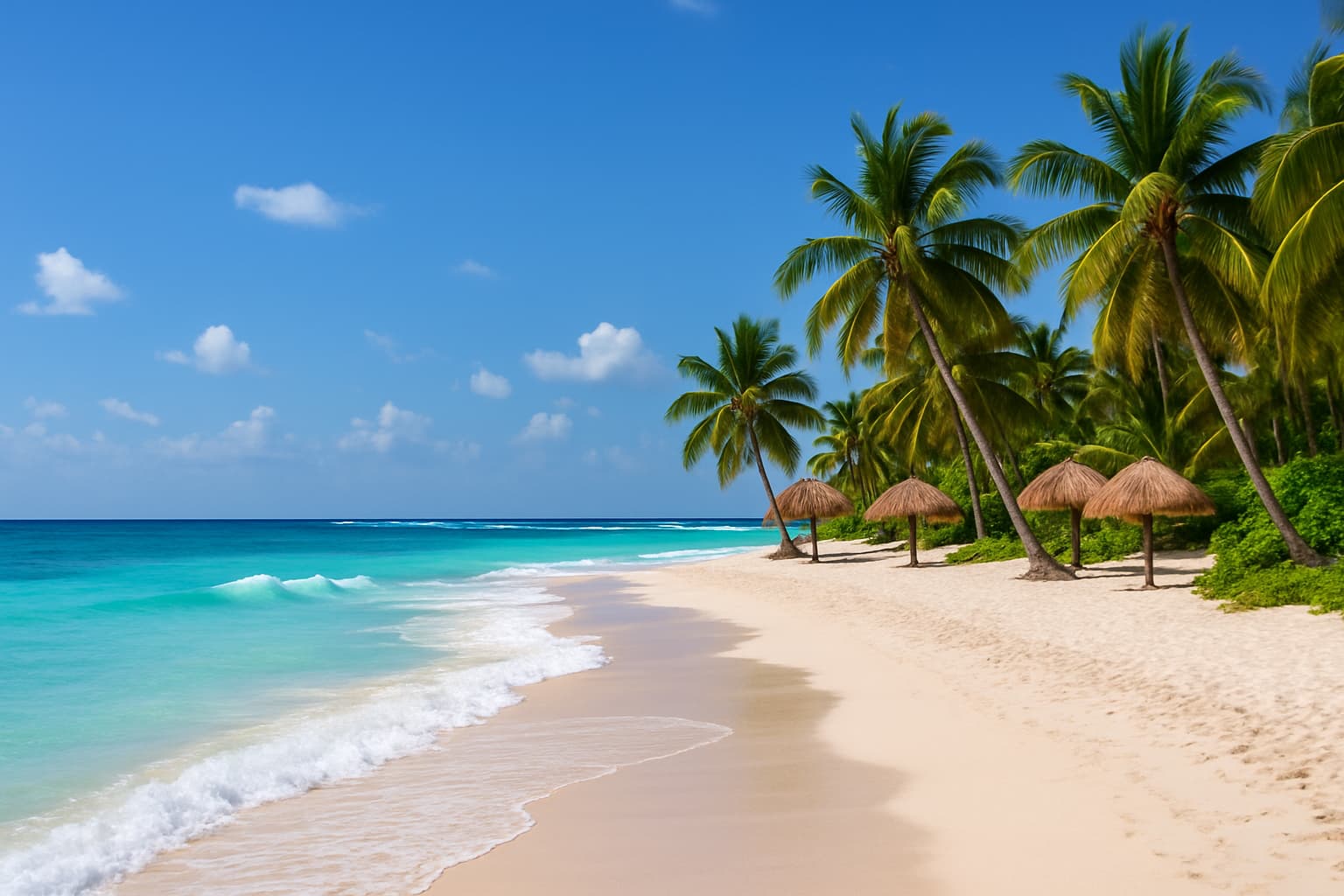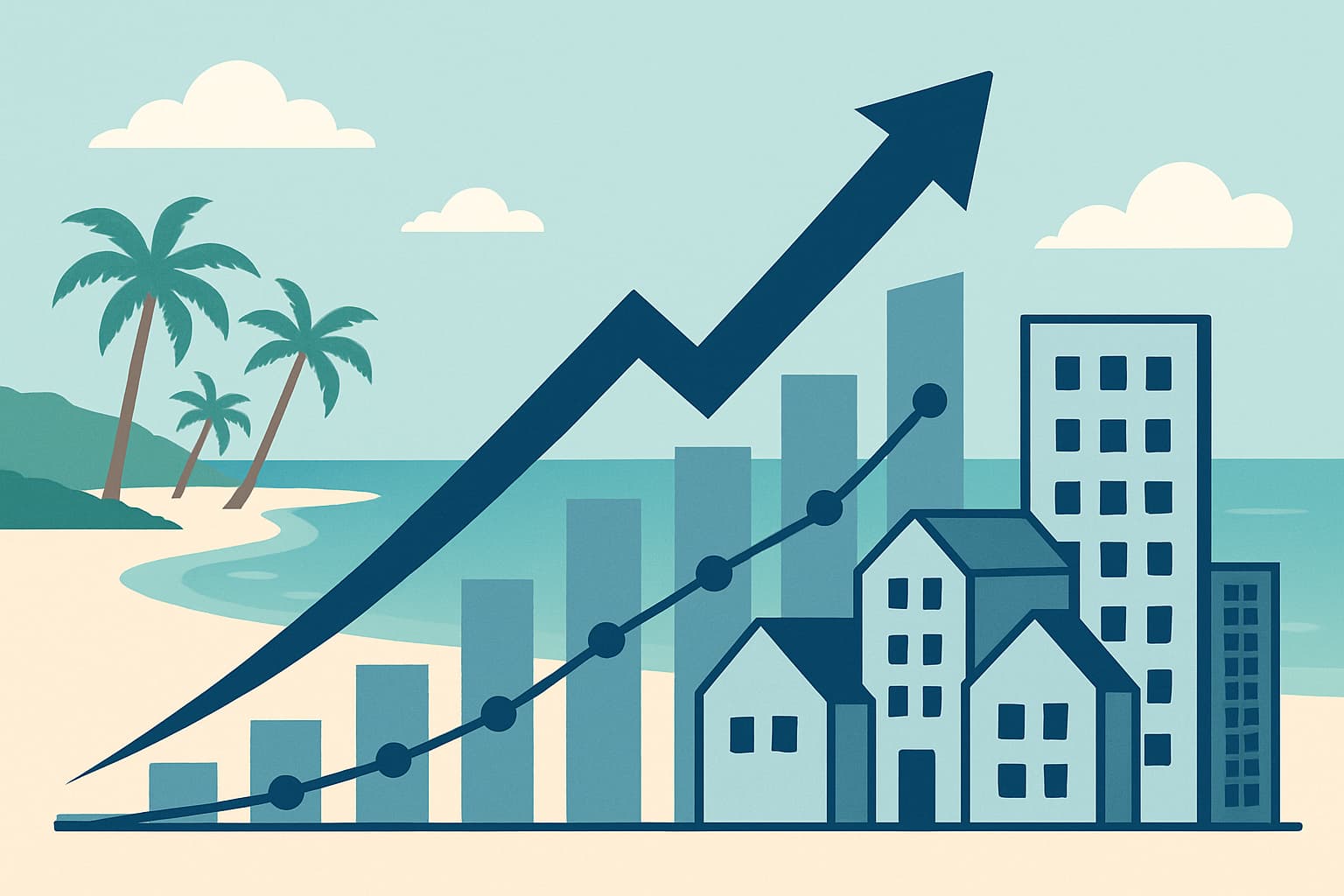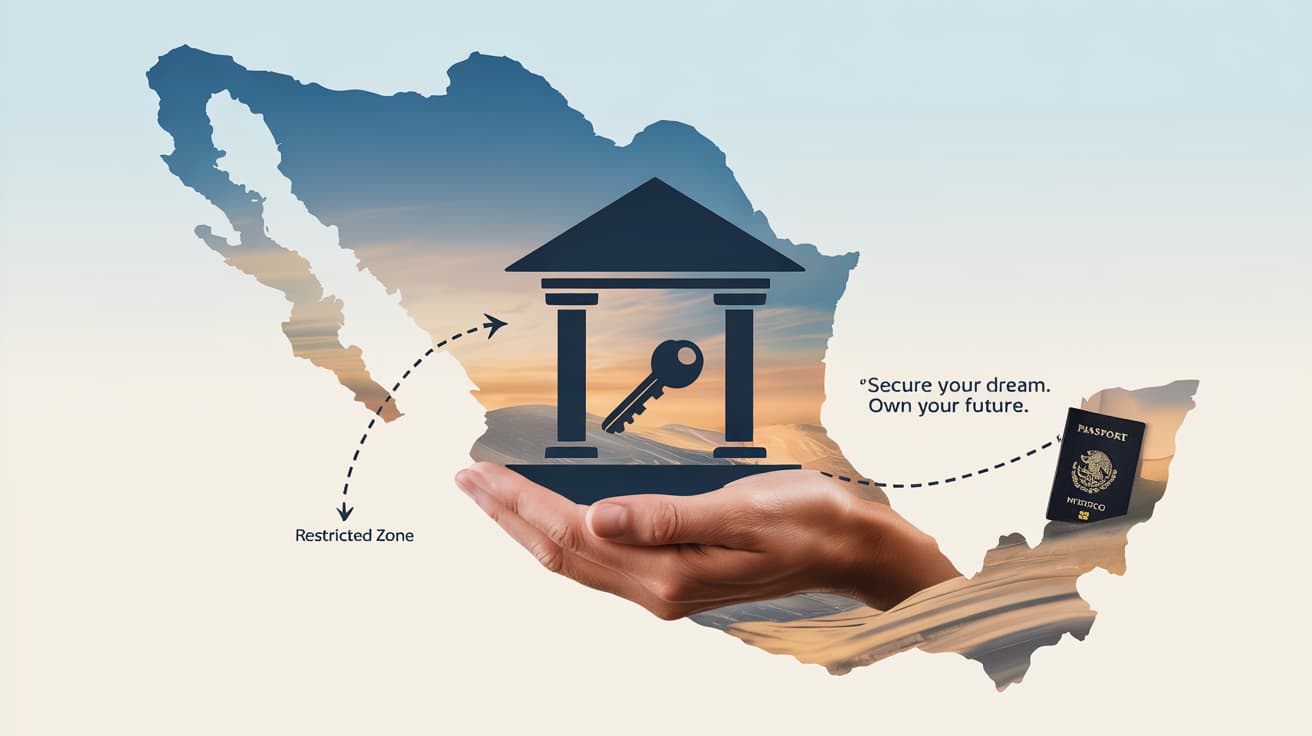Buying property in the Riviera Maya in 2025 might seem like an overwhelming task, but fear not, it’s really not all that complicated with the right resources at your disposal. Stretching along Mexico’s Caribbean coastline, this region offers stunning beaches, a vibrant culture, and strong real estate growth. With continued infrastructure development, including the Maya Train and new international airport in Tulum, accessibility and property values are rising.
If you’re a foreign buyer, you can legally purchase property in Mexico making ownership secure and straightforward. Whether it's a vacation home, rental income, or a permanent residence, the Riviera Maya’s mix of modern amenities and tropical charm makes it a prime choice. This guide will explain the entire step-by-step process in making your purchase, as well as assist you in avoiding any of the common missteps made when undertaking this kind of endeavor. Sea Real Estate Mexico prides itself on utilizing its 18+ years of experience and expertise to help buyers make an informed investment in one of Mexico’s most sought-after coastal regions.

Riviera Maya Real Estate Market in 2025
The Riviera Maya real estate market in 2025 is absolutely booming with growth, due to significant infrastructure developments and increasing demand across various property types. Condo prices in Tulum range from $150 to $225 per square foot, with beachfront units reaching up to $5,000 per square meter. Playa del Carmen sees condo prices between $3,387 and $4,555 per square foot, depending on location and amenities.
Luxury villas in Tulum are priced between $320,000 and over $3 million, offering high rental yields and appreciation potential. Land prices vary significantly; in Playa del Carmen, they range from $168 to $1,250 per square meter, influenced by proximity to the beach and urban developments. Tulum is experiencing rapid growth, especially in eco-friendly developments and luxury beachfront properties. Playa del Carmen remains a mature market with a rising luxury segment; areas like Mayakoba and 5th Avenue are seeing increased demand and higher prices. Puerto Aventuras offers more affordable options, with home prices ranging from $100 to $250 per square foot.
Things only look to be getting better as the region is poised for continued appreciation, with annual rates ranging from 8% to 15%, influenced by infrastructure projects and increased tourism. Tulum's property values are projected to appreciate by 20-25% due to the new airport and Maya Train. Both of these are pivotal in enhancing accessibility, thereby increasing property values and rentals. These developments will undoubtedly boost tourism and attract long-term investments, particularly in areas with direct access. You will definitely want to set your strategic infrastructure development plans in motion to take advantage of this unique opportunity.

Benefits of Buying Property in Riviera Maya
You might be asking yourself, why you should be buying property in the Riviera Maya in 2025. Well there’s no better time than now as this region offers a blend of lifestyle, financial, and practical benefits that are only getting better. This is no surprise since the Riviera Maya boasts a year-round tropical climate, world-famous white-sand beaches, and a rich blend of Mayan culture and modern luxury. Whether it's Tulum's eco-chic vibe or Playa del Carmen's lively urban feel, the area offers something for all walks of life.
From an investment standpoint, demand continues to rise due to tourism, remote work trends, and ever-growing international interest. Vacation rentals yield strong returns, especially in high-traffic zones near the beach or new transport links like the Maya Train and Tulum International Airport.
Mexico also offers tax incentives for property owners, including deductions on property-related expenses, while annual property taxes remain low compared to the U.S. and Canada. Accessibility is a major draw as Riviera Maya is just a few hours by direct flight from cities like New York, Miami, Toronto, and Houston.
Healthcare and amenities in the region have also advanced significantly in 2025, with modern clinics, private hospitals, and international schools attracting families and retirees. This combination of natural beauty, strong infrastructure, and investment potential makes Riviera Maya an appealing option for the smart property buyer, looking for both lifestyle and long-term value.
Foreign Ownership in Mexico - The Essentials
In Mexico, foreign buyers purchasing property within 50 km (31 miles) of the coastline or 100 km (62 miles) from international borders such as in the Riviera Maya must use a fideicomiso, or bank trust. This legal structure allows non-Mexican citizens to acquire residential property in the “restricted zone” while enjoying full rights of ownership. The fideicomiso is established with a Mexican bank acting as trustee, holding the title on behalf of the buyer, who retains all ownership rights, including the ability to sell, lease, or pass the property to heirs. Trusts are typically valid for a period of 50 years and are also renewable.
Outside restricted zones, foreigners can directly own property without a trust, often via a simple deed (escritura pública) through a Mexican notary.
As of 2025, there have been no major legal reforms removing the fideicomiso requirement, though discussions around reforming the system to allow direct ownership in coastal areas continue. Foreigners must still comply with anti-money laundering regulations and provide proper identification and documentation when purchasing.
Foreign property owners enjoy the same rights as nationals in terms of usage and profit, but cannot directly acquire ejido (communal) land unless it has been regularized. Owners are responsible for annual property taxes and maintenance obligations.
Property ownership can support temporary or permanent residency applications. In 2025, Mexico continues to offer pathways such as the “Residente Temporal” visa for property owners demonstrating sufficient income or assets, which can lead to permanent residency and, eventually, citizenship if desired.

The Step-by-Step Buying Process
The step-by-step buying process is as follows:
- Property Search & Identification: Begin by selecting a qualified local real estate agent familiar with the Riviera Maya market. Determine your goals—investment, vacation, or retirement—and narrow your search by location (e.g., Playa del Carmen, Tulum, Puerto Aventuras) and property type (condo, villa, land). Agents often have access to both listed and off-market properties.
- Offer & Negotiation: Once you find a property, your agent will help you submit a written offer. Most properties are listed in USD and there is typically room for negotiation. Your offer may include conditions such as repair requests or inclusion of furnishings. Expect a counteroffer and negotiation until both parties agree.
- Due Diligence Period: After acceptance, a legal review begins. A notario (public notary) verifies the title, permits, liens, property boundaries, and the seller’s legal authority. A property inspection is also recommended. This period typically lasts 2–4 weeks and protects your interests before committing to the purchase.
- Closing Process & Timeline: Closing usually takes 30–60 days. Foreigners purchasing in the restricted zone (most of Riviera Maya) must establish a fideicomiso (bank trust), which can take several weeks. The notario prepares the deed, coordinates with the bank, and collects closing fees (typically 5–8% of the purchase price). Funds are transferred through escrow.
- Required Documentation for Foreign Buyers: Buyers need a valid passport, proof of address, immigration status (tourist visa is acceptable), and tax ID (RFC). Your attorney or agent will guide you through this.
- Post-Purchase Considerations: After closing, set up utilities, internet, and property tax payments. Most buyers hire a property manager to handle maintenance and rentals. If using the home as a vacation rental, ensure you register it per local rental laws.
Financing Your Purchase
Most real estate transactions in the Riviera Maya are cash purchases, which simplifies the process and often gives buyers stronger negotiation power. However, if you are looking for alternatives, several financing options are now available in 2025.
Developer financing is increasingly popular, particularly in pre-construction projects. Terms typically include down payments of 30–50% with interest-free or low-interest monthly payments for 12–36 months. These are ideal for buyers who require flexibility without traditional bank loans.
International mortgages from select Mexican and international lenders are increasingly accessible in 2025, though interest rates may be higher than in the U.S. or Canada. Approval requires proof of income, credit history, and legal residency status in certain cases.
American buyers may also use self-directed IRAs to invest in Riviera Maya property for rental income or long-term growth. This requires a custodian experienced in foreign real estate transactions.
Given currency fluctuations, timing your exchange can significantly impact the final cost. Working with a foreign exchange specialist can help lock in favorable rates.
In 2025, new fintech platforms offer streamlined, cross-border financing and payment solutions, allowing buyers to manage transactions digitally with better rates and transparency, making property acquisition smoother than ever.
Understanding Costs Beyond the Purchase Price
When buying property in the Riviera Maya, it is essential to budget for costs beyond the purchase price. Closing costs can typically range from 5% to 8% of the property value. These include a 2% acquisition tax, notary fees, registration fees, and for foreign buyers, fideicomiso (trust) setup costs, which range from $1,500 to $2,500 USD.
Annual costs are relatively low. Property tax (predial) is about 0.1% of the assessed value. Trust maintenance fees average $500-$700 USD per year, paid to the bank managing your fideicomiso.
For condos, expect HOA fees from $100 to $500+ USD monthly, depending on amenities and location. If you are renting your property, property management services usually cost 20%–30% of rental income.
Home insurance, including hurricane coverage, typically runs $400–$1,000 USD annually, based on property value and coverage level. Understanding these ongoing expenses ensures a smoother ownership experience in the Riviera Maya.
Location Guide - Finding Your Ideal Spot
Choosing the right spot can be tricky if you do not have the right information. Thankfully this guide will provide an extensive overview of many of the most promising areas of The Riviera Maya.
Playa del Carmen is a vibrant hub with numerous diverse neighborhoods. Downtown/5th Avenue is ideal for short-term rentals, while Playacar offers gated luxury homes and condos. New developments in El Cielo and Luis Donaldo Colosio attract budget-conscious investors seeking long-term appreciation.
Tulum continues to be booming, with high demand in Aldea Zama, La Veleta, and Region 15. These areas blend eco-conscious design with luxury living. With the addition of the new airport and Maya Train, Tulum offers high rental yields and capital appreciation potential, especially in pre-construction projects.
Puerto Aventuras is a secure, marina-front community with golf, schools, and beach access—perfect for families and retirees. Homes and condos here offer steady rental returns and long-term value.
Akumal is known for its tranquil beaches as well as its sea turtle sanctuaries. Properties near Half Moon Bay and Yal-Ku Lagoon appeal to eco-luxury buyers seeking peace and privacy.
Puerto Morelos, located only 25 minutes from Cancun Airport, is emerging with beachfront condos and boutique developments. It’s ideal for early investors looking for lower price points and strong future ROI.
Costa Mujeres, north of Cancun, is rapidly growing with high-end resorts and many residential projects. It is an ideal situation for investors seeking luxury and long-term growth.
In regards to comparative ROI, Tulum and Playa del Carmen lead in short-term rental income, with Tulum offering the higher appreciation potential. Puerto Aventuras and Akumal provide stability, while Puerto Morelos and Costa Mujeres offer the best opportunities for early-stage gains.
Property Types and Investment Strategies
Investing in Riviera Maya offers diverse options to suit various goals. Condominiums are the most popular, especially in Tulum and Playa del Carmen. Pre-construction units offer lower entry prices and high appreciation potential but require patience and developer due diligence. Existing condos provide immediate rental income and less risk.
Single-family homes are ideal for retirees and families seeking long-term living. Gated communities such as Playacar or Puerto Aventuras offer safety, amenities, and strong resale value.
Vacation rentals remain a profitable strategy. Platforms like Airbnb thrive in tourist zones, but investors must comply with local laws, such as business registration and lodging taxes. Many owners hire property managers to handle bookings, maintenance, and guest services, often for 20–30% of rental income.
Land investment offers high returns, particularly in growing areas like Region 15 (Tulum) or Puerto Morelos. However, investors must ensure land is titled, not ejido (communal), and suitable for development.
Commercial properties, such as shops, cafes, or mixed-use spaces near tourist hotspots are gaining traction as tourism and population grow. With the right location and business plan, commercial real estate can offer robust, long-term cash flow.
Due Diligence - What to Check Before Buying
Conducting thorough due diligence is essential before purchasing property in the Riviera Maya. Start with title verification through a licensed notary (notario público), who ensures the seller has legal ownership and the property is properly registered with the Public Registry.
Next, request a property survey to confirm boundary lines and verify that the property matches legal descriptions. This is especially important for land or homes near protected zones or the coastline.
A professional building inspection should assess the structure, plumbing, electrical systems, and signs of moisture or foundation issues—particularly in humid, coastal areas.
If buying a condo, carefully review the HOA bylaws, financials, and fees. Ensure there are no outstanding debts or legal issues with the association.
Always check for liens or encumbrances that may affect ownership or usage rights. The notary will confirm this, but having your own legal advisor in order to double-check provides an added layer of protection.
In environmentally sensitive areas such as Tulum, it is important to review any environmental restrictions, zoning regulations, or permits required for development. Violating these can lead to fines or halted construction.
Proper due diligence ensures both a secure and successful investment in this wonderful region.
Working With Professionals
Navigating the Riviera Maya real estate market requires a trusted team of professionals. Start by selecting a qualified buyer’s agent who specializes in the area and represents your interests exclusively. They help identify properties, negotiate, and coordinate with other professionals.
A notario público is a government-appointed attorney who oversees the legal transfer of property, verifies title, and ensures taxes and fees are paid. While essential, the notary represents the state, not the buyer—so hiring an independent real estate attorney is a wise move for added protection and contract review.
If you’re not fluent in Spanish, a certified translator helps ensure you fully understand all legal documents. For physical property assessments, hire a licensed inspector and surveyor to evaluate the structure and confirm land boundaries.
Finally, an accountant familiar with Mexican tax law can assist with tax planning, especially if you’re earning rental income or using the property for investment.
Common Pitfalls and How to Avoid Them
Investing in Riviera Maya real estate is rewarding, but avoiding common pitfalls is key. Many buyers have unrealistic price expectations, especially with pre-construction deals—compare market comps and factor in total costs. Incomplete title research can lead to ownership disputes, so, ensure a notary and attorney confirm clear, lien-free title.
Never skip inspections—tropical climate and poor construction practices can hide costly issues. In condos, review HOA rules, fees, and financials to avoid unexpected assessments or mismanagement.
Be cautious with construction quality, especially in rapidly growing areas like Tulum—hire an independent inspector and work with reputable developers. Rental income overestimation is another risk; base projections on actual occupancy rates, not developer promises.
Finally, don’t overlook tax implications—rental income must be declared in Mexico and may impact your home country taxes. A local accountant can help you stay compliant and maximize your investment.
Sustainability and Eco-Considerations
Sustainability and eco-considerations are central to development in the Riviera Maya, a region renowned for its natural beauty and biodiversity. Eco-friendly properties and green developments are steadily on the rise, blending luxury along with low-impact living. Many resorts now use solar panels, rainwater harvesting, and energy-efficient systems to reduce environmental footprints.
Water conservation is crucial due to the fragile underground river systems and cenotes. Strict building restrictions in protected areas like Sian Ka’an Biosphere Reserve help preserve ecosystems. Sustainable building practices, such as using local natural materials and passive cooling designs are gaining popularity.
Certification programs such as LEED and EarthCheck play a significant role by ensuring developments meet global environmental standards, attracting conscious travelers and investors. These combined efforts reflect a growing commitment to preserving the Riviera Maya’s unique environment while promoting responsible tourism and development. The balance between growth and conservation defines the region’s path forward.

What's Next? - After the Purchase
After purchasing a property in Riviera Maya, the next steps include setting up essential utilities like electricity, water, internet, and possibly solar energy services. Many owners choose property management companies to handle maintenance, bill payments, and rental logistics, especially for vacation homes.
If you plan to rent, consider local rental regulations, marketing platforms, and guest services. Building a local network of trusted service providers/contractors, cleaners, as well as legal advisors is invaluable. Once everything is in place, you can fully enjoy your new home, whether it's a peaceful retreat, a vibrant community hub, or a lucrative investment in paradise.
Being aware and informed of each of the steps required to make a purchase in the illustrious region of Riviera Maya will give you a significant competitive edge in the market. Understanding the region, governing laws, steps to take before, during, and after your purchase as well as the additional resources you will require are paramount to making your property purchasing endeavor a flawless success.
For further assistance feel free to contact us! We will be happy to help you set up a tour or consultation and set you on the right track.
